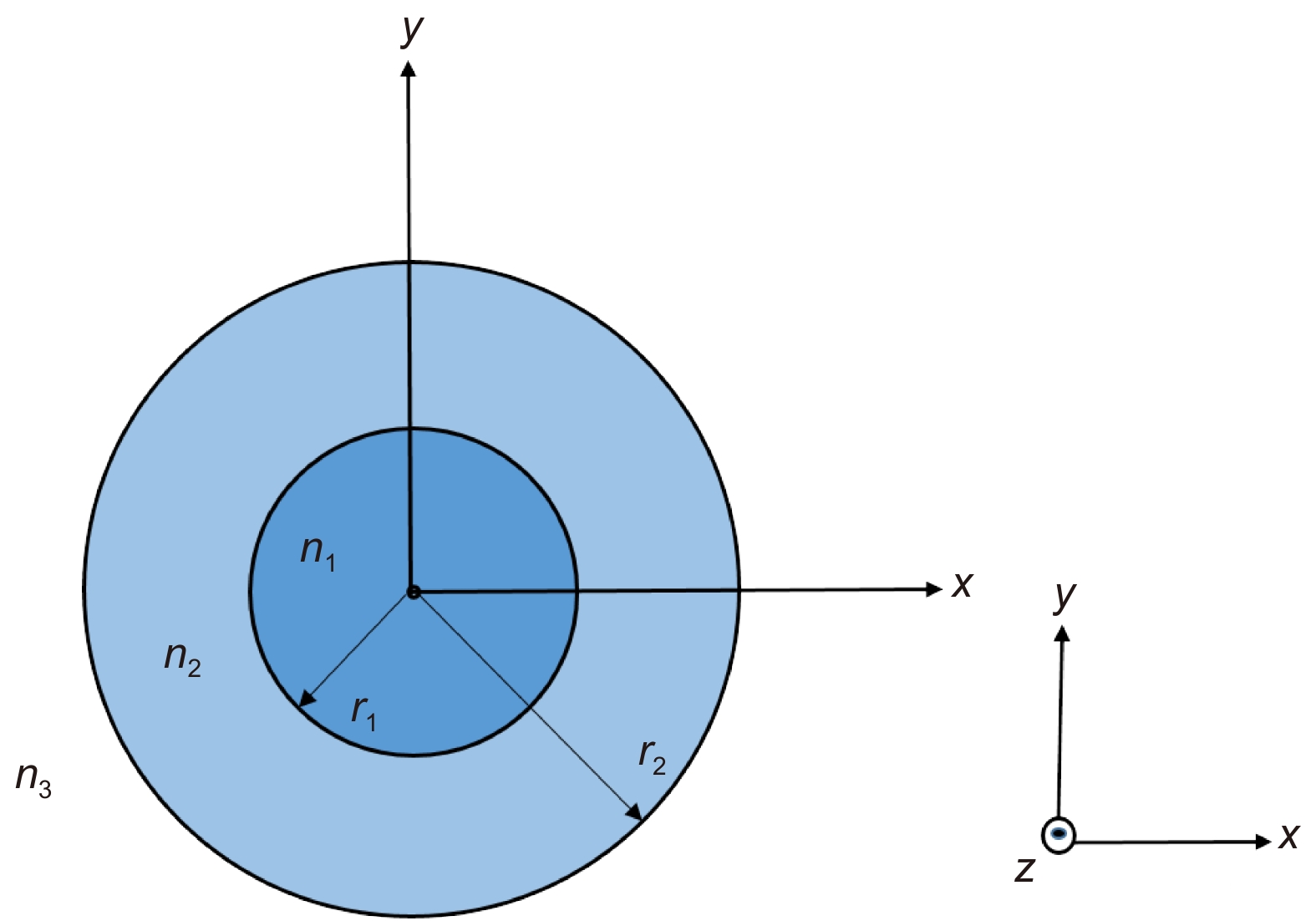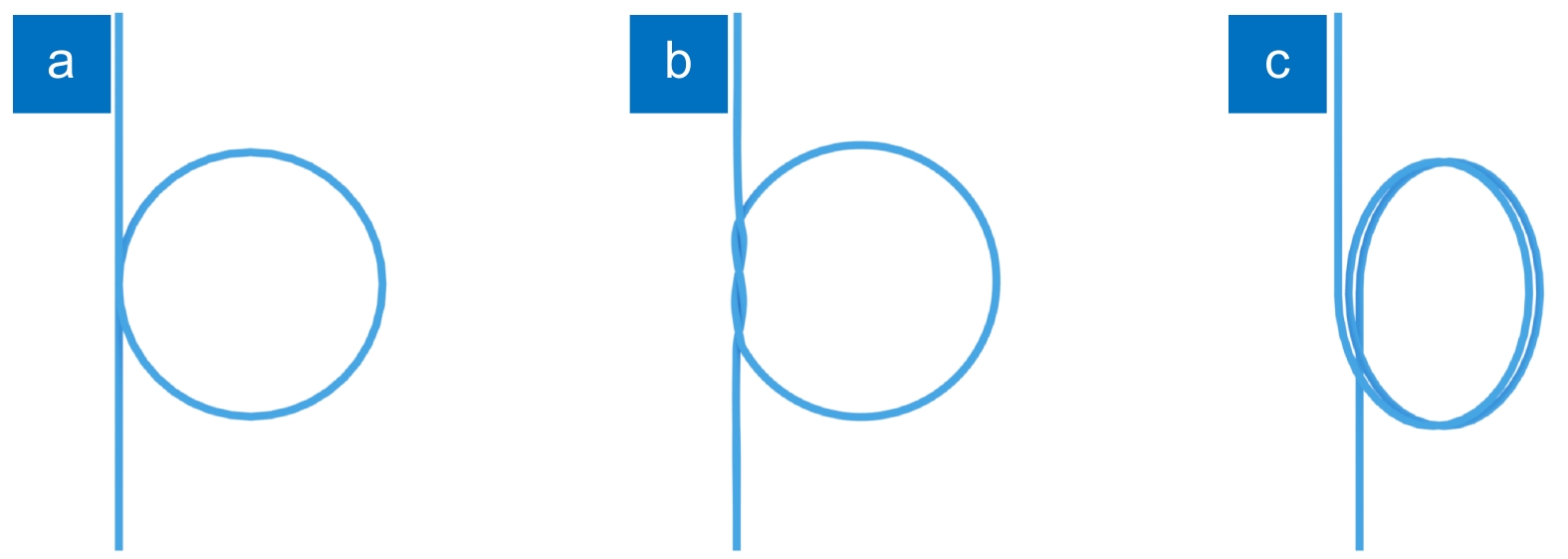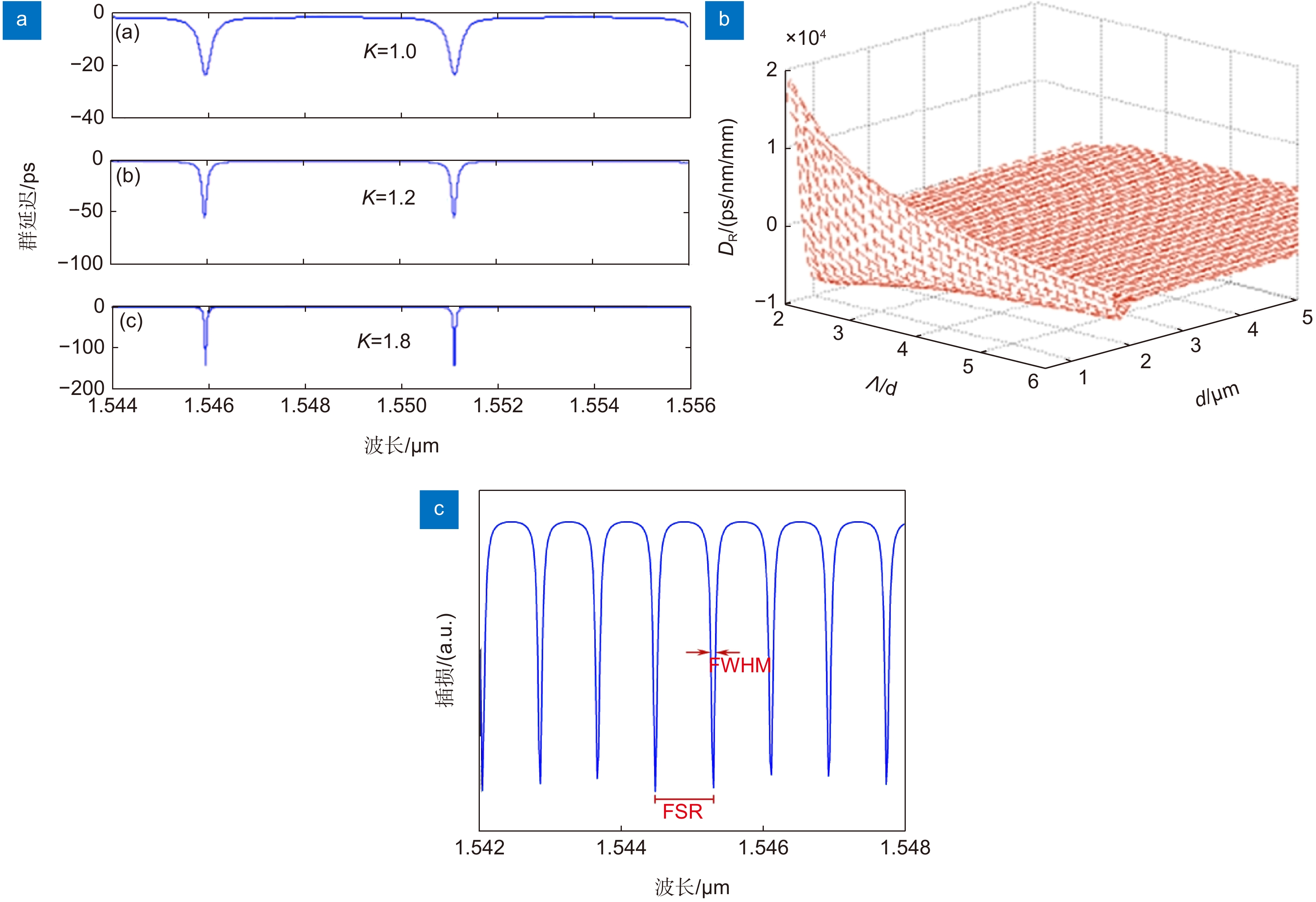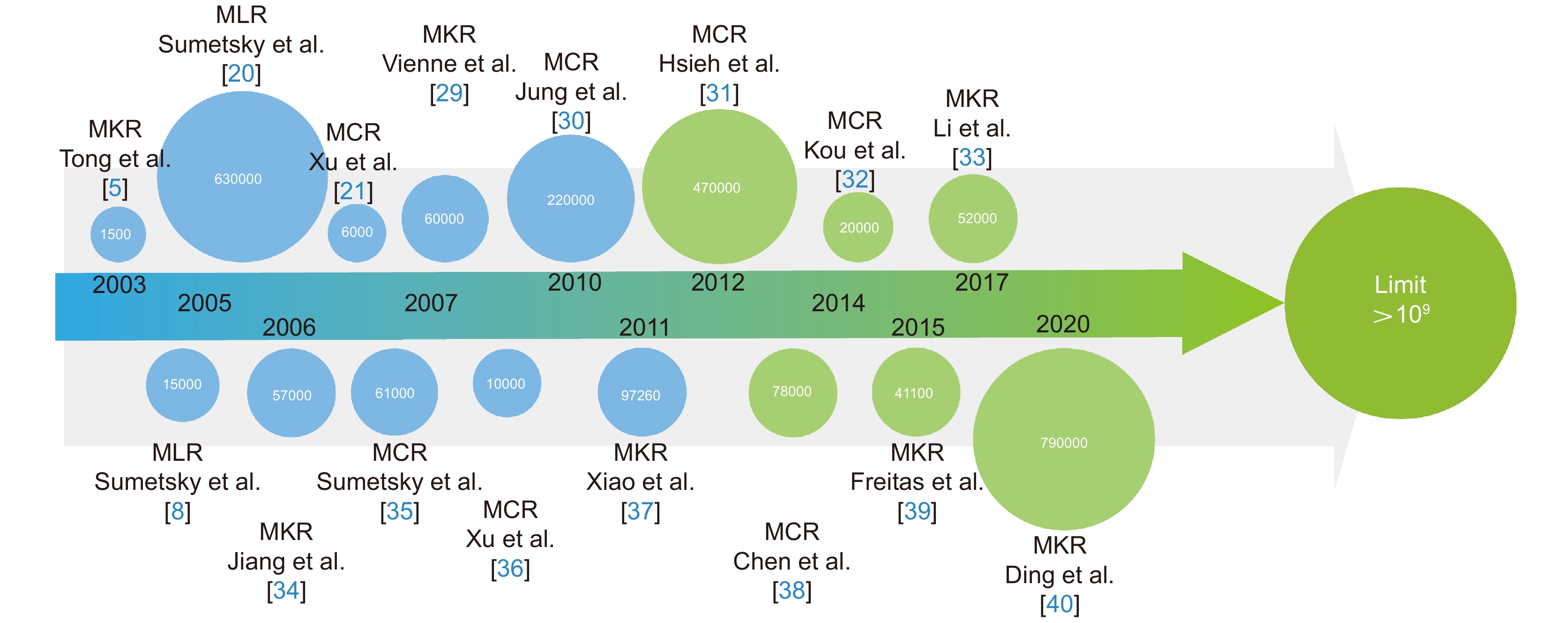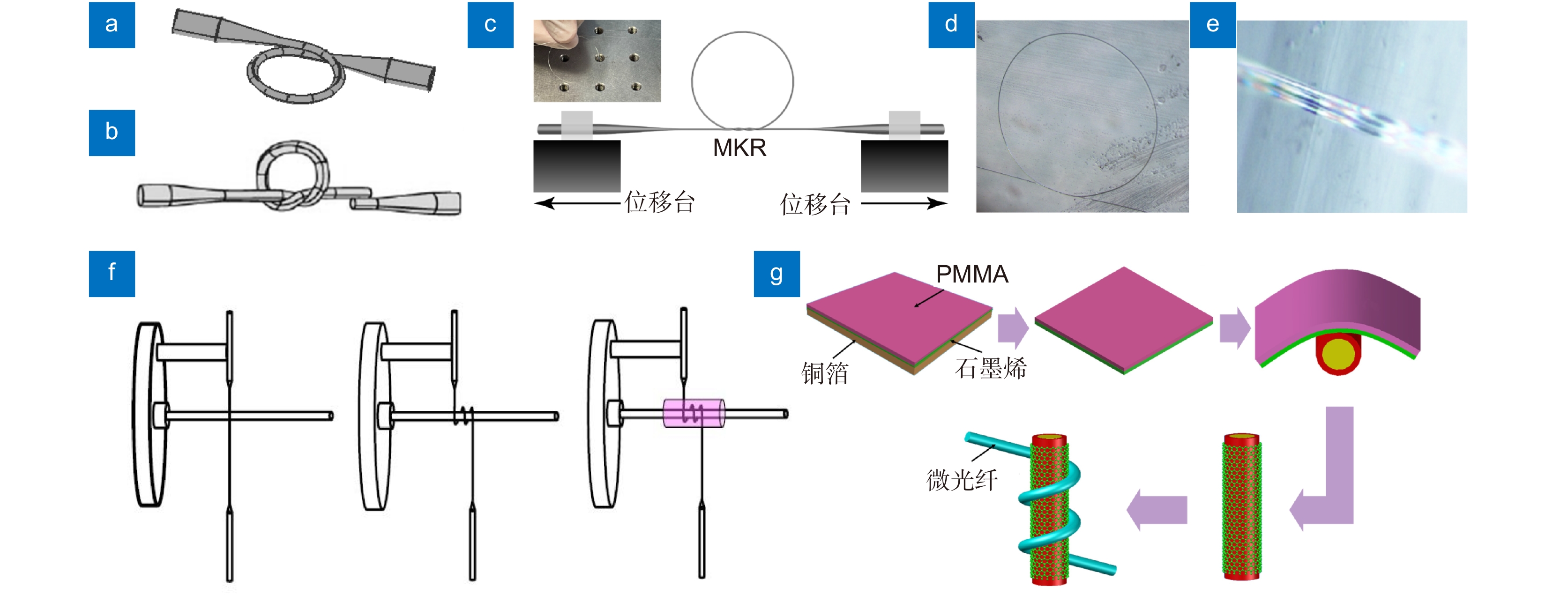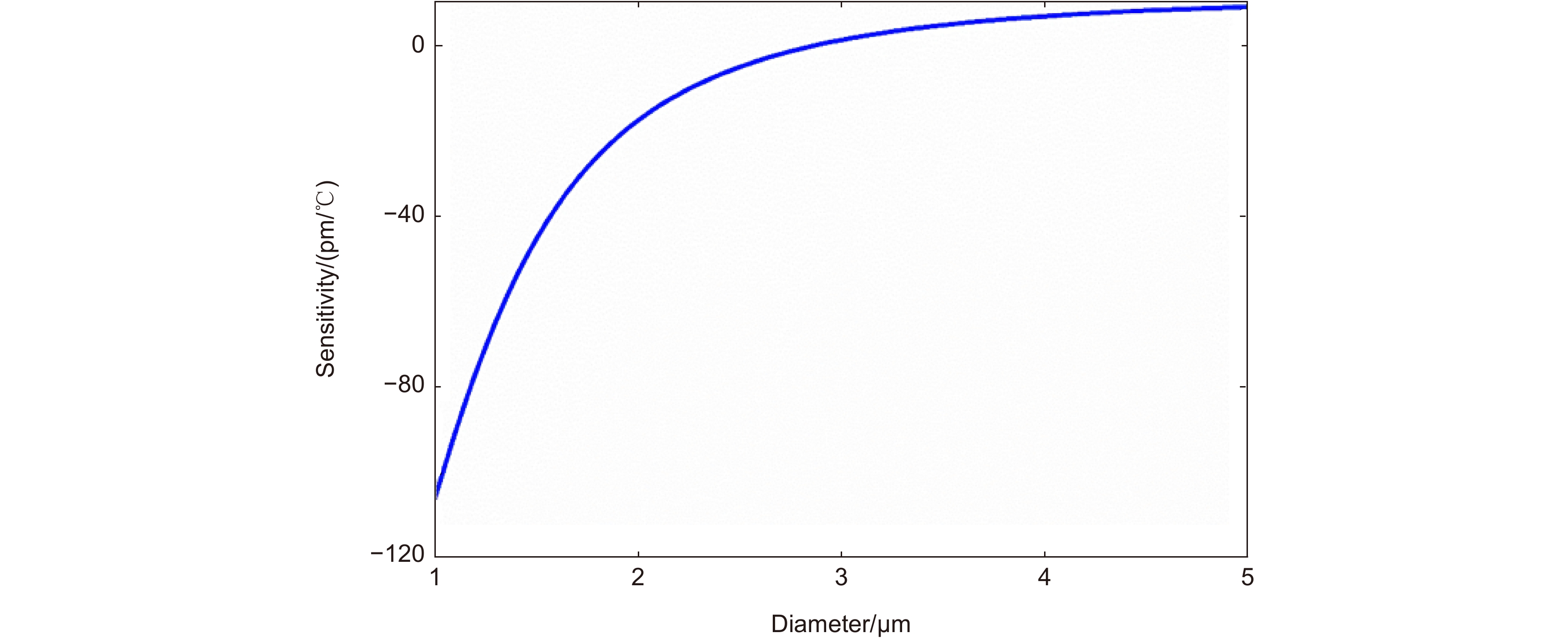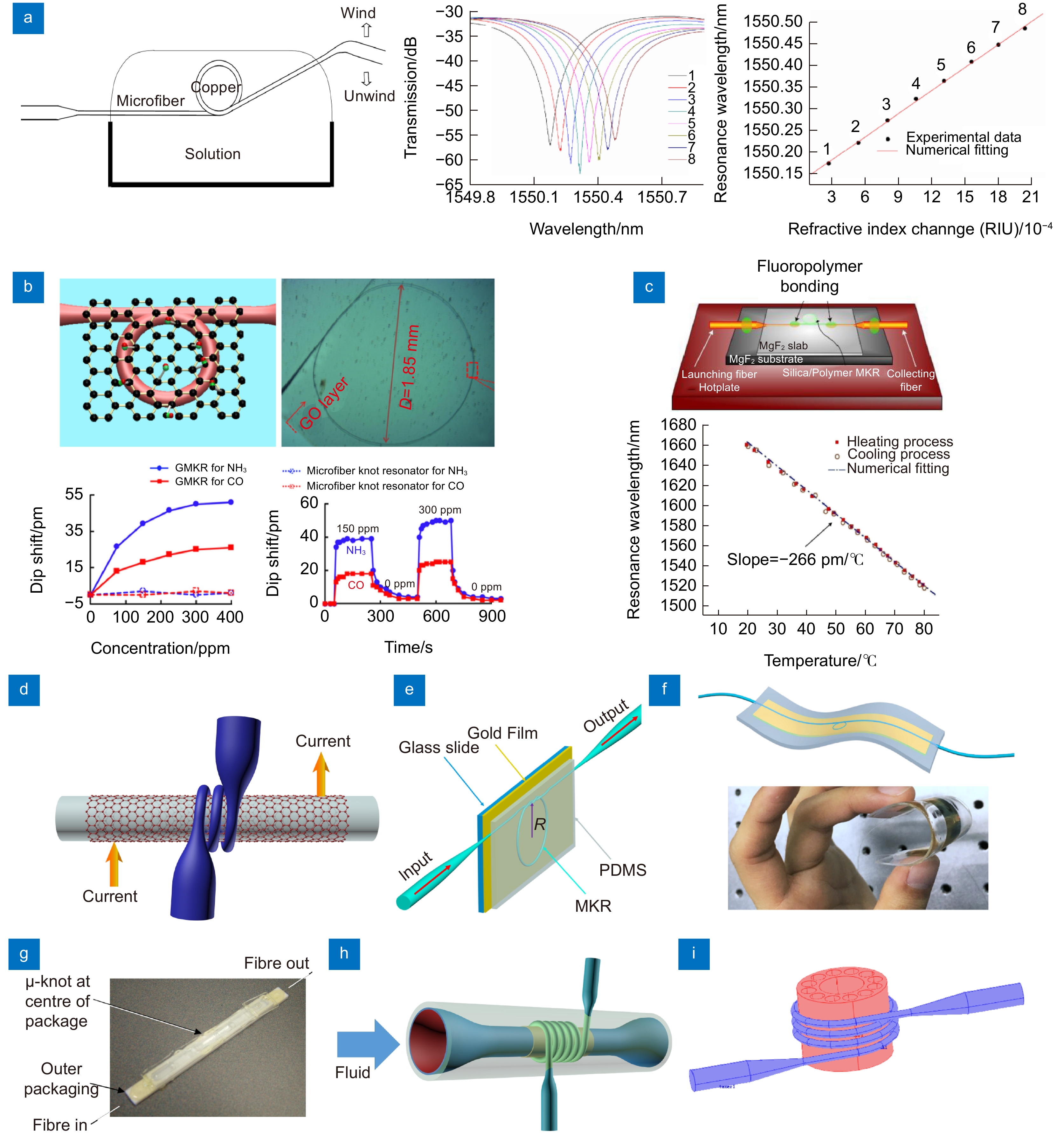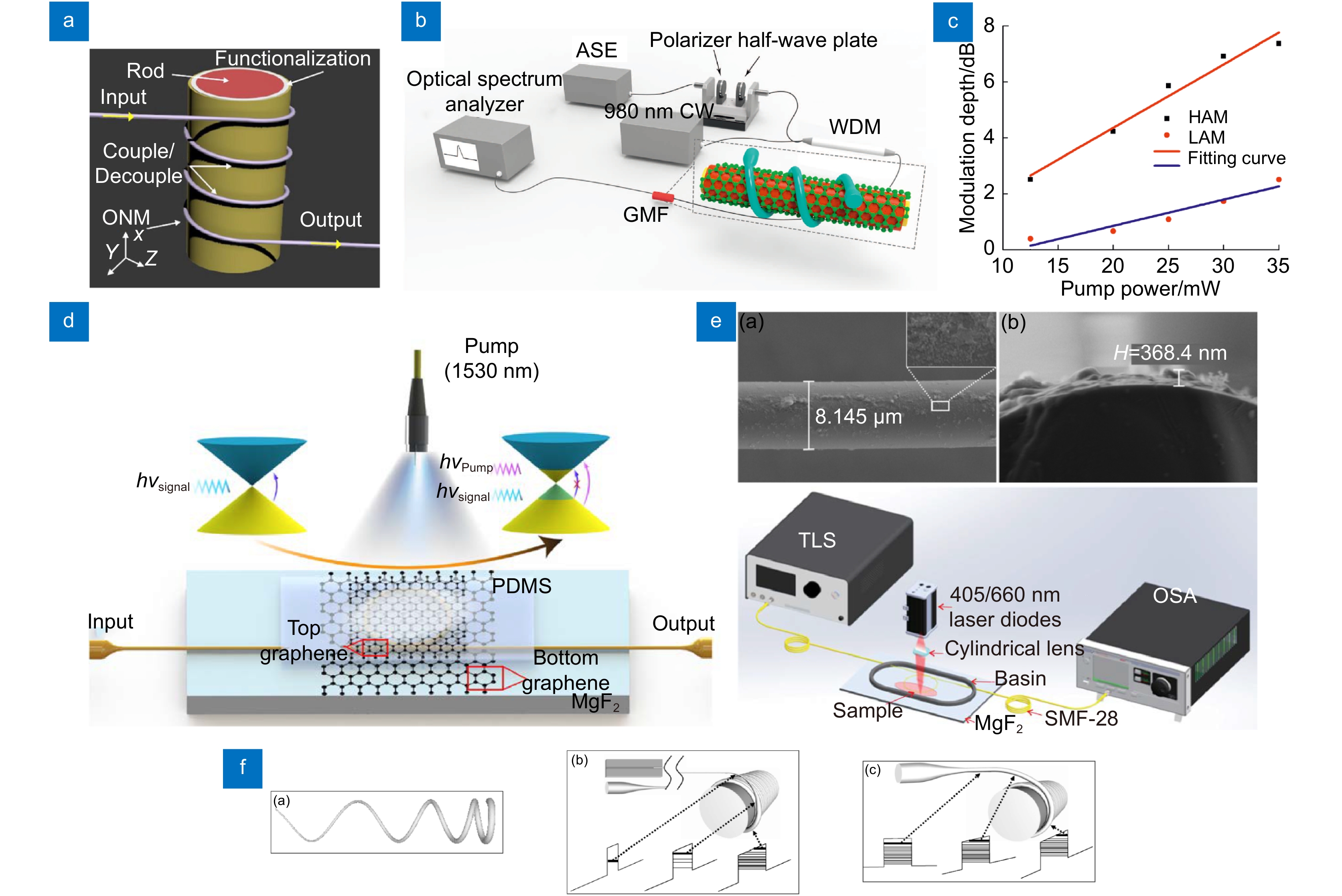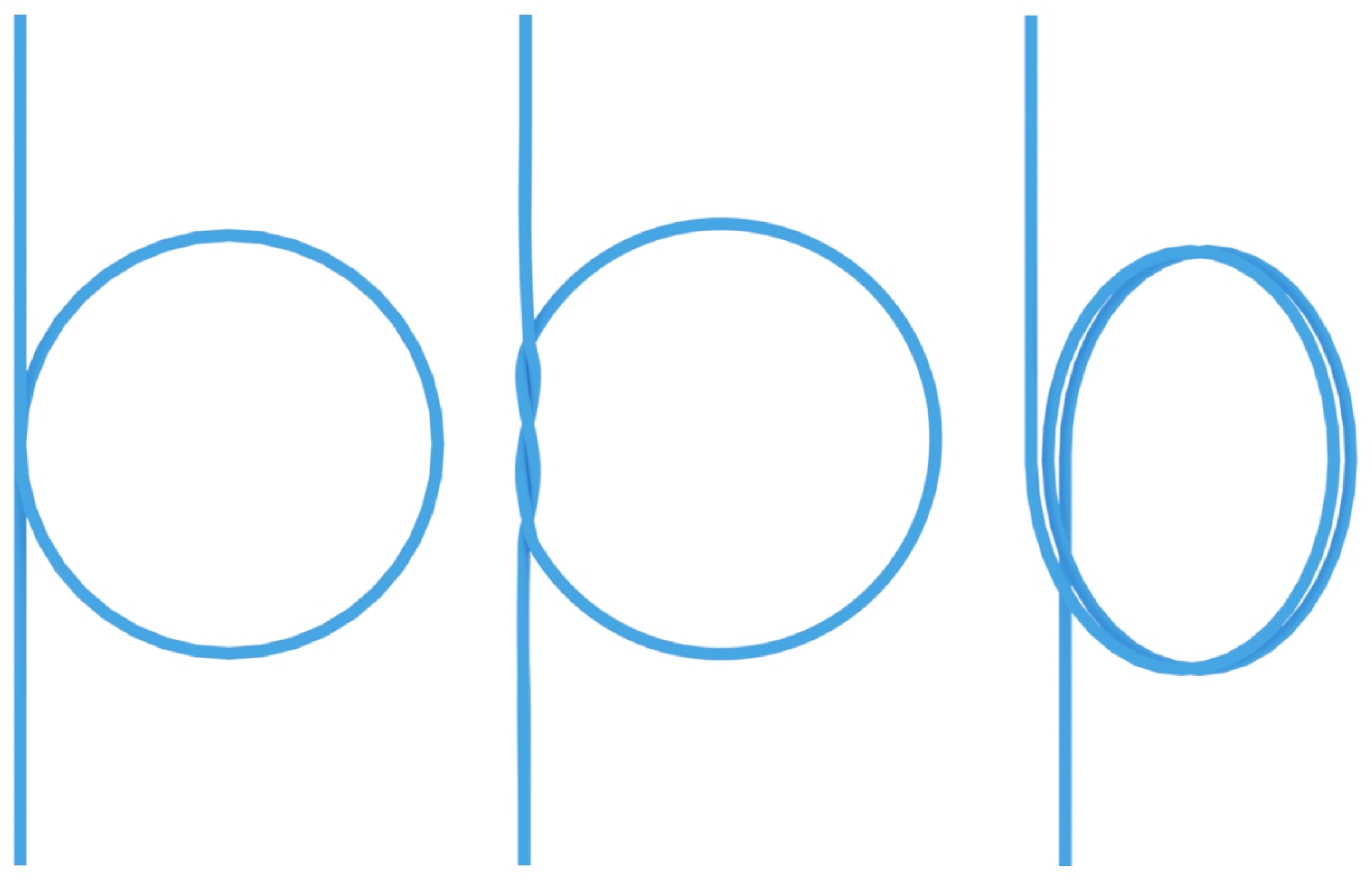-
摘要:
由传统光纤拉锥形成的直径为几百纳米到几微米的微光纤具有大倏逝场、强光场束缚能力、高光学非线性、易于弯曲的可塑性和兼容现有光纤系统的便利性等优势,为发展小型和功能集成的全光纤器件提供了高自由度的平台。作为基础的光电子器件之一,光学谐振器在光通信、传感、信号处理、量子光学等领域具有很大的研究价值,被广泛应用。传统光学微谐振器多基于光刻技术,制备工艺条件相对复杂。而随着微光纤制备技术的成熟,基于微光纤的光学谐振器也被提出并逐步发展。微光纤光学谐振器是一种基于倏逝场耦合的近场光学耦合器件,具有低插入损耗、高精细度、易于制造以及与光纤系统良好兼容性等诸多优点,可应用于滤波器、传感器、光调制器和光纤激光等诸多领域。本文从微光纤光学谐振器的基本原理、器件制备、应用等方面介绍了该领域的相关进展。
Abstract:Microfibers tapered from conventional optical fibers with diameters ranging from hundreds of nanometers to several micrometers possess various advantages including large evanescent field, strong light confinement, high optical nonlinearity, flexible configurability, and low-loss connection to other fiberized systems, which makes it an open platform for miniaturization and integration of all-fiber devices. As a fundamental opto-electronic component, optical resonators have got comprehensively researched and widely applied in the fields of optical communication, sensing, signal processing, and quantum photonics. Traditional optical resonators are fabricated through lithography which is relatively complicated. With the maturation of microfiber fabrication methods, optical resonator based on optical microfibers was demonstrated and developed. As an optical coupling device based on evanescent field coupling, the microfiber resonator features in low insertion loss, high finesse, easy fabrication, and compatibility with fiber systems. It can be utilized in domains of filter, sensor, modulator, and fiber laser. In this article, we summarize the recent progress in the microfiber resonators research fields, covering fundamental characteristics, fabrication methods, and applications of microfiber resonators.
-
Key words:
- microfiber /
- resonator /
- optical fiber sensing /
- optical modulation
-
Overview: Microfibers tapered from conventional optical fibers with diameters ranging from hundreds of nanometers to several micrometers possess various advantages including large evanescent field, strong light confinement, high optical nonlinearity, flexible configurability, and low-loss connection to other fiberized system, which makes it an open platform for miniaturization and integration of all-fiber devices. Nowadays microfiber can be easily obtained through mature fabrication method like flame-brushing technique. On the other hand, as a fundamental opto-electronic component, optical resonators have got comprehensively researched and widely applied in the fields of optical communication, sensing, signal processing, and quantum photonics, including whispering-gallery-mode cavities like micro-ring, micro-cylinder, micro-toroid, and micro-sphere. These traditional optical resonators are fabricated through lithography which is relatively complicated. With the maturation of microfiber fabrication methods, optical resonators based on optical microfibers have been demonstrated and developed, such as microfiber loop resonators, microfiber knot resonators, and microfiber coil resonator. As an optical coupling device based on evanescent field coupling, the microfiber resonator features in low insertion loss, high Q-factor, high finesse, excellent mechanical stability, easy fabrication process, and compatibility with fiber systems, providing a broad platform for all-fiberized miniatured devices of probing and modulation. Through further integration with exterior functional materials and microfabrication techniques, a microfiber resonator can be utilized in diverse domains of sensor, filter, modulator, and fiber laser, as well as quantum photonics and nonlinear optics, realizing the ‘lab on fiber-ring’. In the field of sensing, the microfiber resonators get exploited as the refractometric sensor, concentration and humidity sensor, temperature and current sensor, mechanical pressure sensor, microfluidic sensor, magnetic field sensor, acceleration sensor, etc., where the devices exhibit high adaptability and excellent sensitivity. As to optical signal processing, the device can be used as the single wavelength or multi-wavelength filter, code-type conversion, and optical modulation. The intensity and phase of light can be tuned to a large scale within broad wavebands, and the modulation response time is also reduced to achieve high-speed modulation. Furthermore, the microfiber resonator can be used as an optical delay line or generator of second harmonic or third harmonic. When applied into fiber laser, the microfiber resonators help build the stable light source with narrow linewidth single frequency or multiwavelength laser with high uniformity. The devices integrated with metal or 2D materials also make the laser operate under conventional soliton mode-locking or dissipative four-wave-mixing mode-locking regime and output sub-picosecond pulsation, broadening the dynamics of ultrafast optics. In this article, we summarize the recent progress in the microfiber resonators research fields, covering fundamental principles and characteristics, fabrication methods, and applications of microfiber resonators.
-

-
图 3 (a) 不同直径的阶跃型光纤HE11和HE12模的有效折射率;(b) 包层直径分别为80 μm及20 μm时的模场分布[25]; (c) 800 nm波长下微光纤不同高阶模有效折射率随直径的变化
Figure 3. (a) Effective refractive index of HE11 and HE12 mode for step-index fiber with varied diameter; (b) Cross-section mode field distribution of fiber with cladding diameter of 80 μm and 20 μm[25]; (c) Variation of effective refractive index for high-order modes in microfiber versus diameter at wavelength of 800 nm
图 9 微光纤谐振器的制备。 (a) MLR的制备;(b) MKR打断式制备;(c) MKR完整式制备;(d) MKR样品实物显微照片;(e) 三圈MCR样品实物显微照片;(f) MCR的制备;(g) 石墨烯集成MCR的制备
Figure 9. Fabrication of microfiber resonator. (a) Fabrication of MLR; (b) MKR’s cutting-end fabrication; (c) MKR’s complete fabrication; (d) Microscopic image of MKR; (e) Microscopic image of MCR; (f) Fabrication of MCR; (g) Fabrication of graphene-integrated MCR
图 11 微光纤谐振器传感。(a) 基于MLR的折射率传感器[52];(b) MKR与氧化石墨烯集成的气体传感器[62];(c) 基于MKR的温度传感器[64];(d) 基于石墨烯集成MCR的电流传感器;(e) 混合等离激元MKR;(f) 柔性可穿戴HPMKR传感器;(g) 基于MKR的光纤水听器[39];(h) MCR微流体传感器;(i) 基于MCR的三维立体光栅
Figure 11. Sensors based on microfiber resonators. (a) Refractometric sensor based on MLR[52]; (b) Graphene oxide deposited MKR for gas sensing[62]; (c) Temperature sensor based on MKR[64]; (d) Current sensor based on graphene-integrated MCR; (e) Hybrid-plasmonic MKR; (f) Soft and wearable HPMKR sensor; (g) Fiber hydrophone based on MKR[39]; (h) Microfluidic sensor based on MCR; (i) 3D-stereo grating based on a microstructured rod with MCR
图 12 光信号处理。(a) MCR宽带起偏器[38];(b) 石墨烯集成MCR全光调制器[81];(c) 石墨烯集成MCR全光调制器的偏振相关调制[81];(d) 石墨烯集成MKR全光调制器[82];(e) WS2集成MKR全光调制器[83];(f) MCR光延迟线[84]
Figure 12. Optical signal processing.(a) MCR broad band polarizer[38]; (b) Graphene-integrated MCR all-optical modulator[81]; (c) Polarization-dependent modulation of graphene-integrated MCR all-optical modulator[81]; (d) Graphene-integrated MKR all-optical modulator[82]; (e) WS2-integrated MKR all-optical modulator[83]; (f) MCR delay line[84]
表 1 三种热拉伸制备微纳光纤工艺性能对比
Table 1. Performance comparison of 3 microfiber fabrication methods
表 2 基于微光纤谐振器的传感器件
Table 2. Sensors based on microfiber resonators
谐振器类型 测量对象 灵敏度 参考文献 浓度传感 MCR 异丙基浓度 40 nm/RIU [51] MLR 酒精浓度
甘油浓度17.8 nm/RIU
109.7 nm/RIU[52] MLR 海水盐度 1000 nm/RIU 或 2 nm/% [53] MKR 甲醇、乙醇、丙醇、异丙醇浓度 / [54] MKR NaCl浓度 1.7 nm/% [55] MKR NaCl浓度 0.2 nm/% [56] MKR 湿度 1.2 pm/% (石英光纤)
8.8 pm/% (聚合物光纤)[57] MLR 湿度 1.8 pm/% [58] MKR 湿度 5.95 pm/% [59] MKR 湿度 1.53 nm/% [60] MKR NH3分子浓度
CO分子浓度0.35 pm/ppm
0.17pm/ppm[62] MCR Pb2+离子浓度 702 pm/ppm [63] 温度传感 MKR 温度 280 pm/℃ [65] MKR 温度 266 pm/℃ [64] MLR 温度 0.043 dB/℃ [66] MKR 电流 0.0513 nm/A2 [67] MCR 电流 220.65 nm/A2 [68] MCR 电流 6.7297×104 nm/A2 [69] 应力传感 MKR 压强 51.2 pm/kPa [33] MKR 压强 16.02 pm/kPa [71] MKR 压强 −288 dB re (μPa)−1 [39] 其它 MKR 加速度 29 pm/G [73] MKR 磁场 ~ 0.3 pm/Oe [74] 表 3 基于微光纤谐振器的光信号处理
Table 3. Signal processing based on microfiber resonators
谐振器类型 应用方式 性能参数 参考文献 滤波器 工作波长/nm FSR/nm 精细度 对比度/dB 插损/dB MLR 滤波 840 3.2~3.8 4.3 10 0.97 [75] MKR 通信码型转换 1550 0.32~0.64 / > 10 8 [77] MLR 上下载滤波 1550 0.3~0.64 4~6.5 3.7~7.5 2.5 [78] MKR 滤波 4600 2~9.6 10.2 4~8 > 4 [80] 调制器 工作波长/nm 调制深度/dB 调制效率/(dB/mW) 上升/下降时间/ms MCR 全光调制 1550 7.5 0.2 / [81] MKR 全光调制 1550 7.4 0.02 / [82] MKR 全光调制 1550 17.1 0.4 120/100 [83] MKR 全光调制 1550 12.7 0.5 2.8/3.3 [86] MKR 全光调制 1550 12.9 0.26 0.306/0.301 [87] MKR 热光调制 1550 13.4 / 0.0908/0.0897 [88] 非线性 泵浦光波长/nm 信号光波长/nm 转换效率 谐振腔增强因子 MLR 二次谐波产生 1550 775 2.4 × 10−7 5.7 [89] MLR 三次谐波产生 1550 516.7 1.8 × 10−5 5.9 [90] 表 4 基于微光纤谐振器的光纤激光
Table 4. Fiber laser based on microfiber resonators
谐振器类型 性能参数 参考文献 单波长激光器 中心波长/nm 线宽/pm 对比度/dB 输出功率/μW MKR 1541.1 50 47 8 [34] MKR 1536 3.2 × 10−4 38 0.9575 [94] MKR 1560.6 16 60 / [95] MKR 1550.772 16 60.6 8 × 103 [96] 多波长连续激光器 中心波长/nm FSR/nm 波长通道数 MKR 567~580 0.21 6 [46] MKR 1528.3~1561.3 0.184 11 [97] MKR 1564 0.09 42 [98] MKR 1546.95~1562.29 0.813 1~4 [99] MCR 1882.5 0.54 12 [100] MKR 1965 5.8 3 [101] 多波长脉冲激光器 中心波长/nm FSR/nm 波长通道数 重复频率 脉宽/ps MKR 1535 1.12 7 5.3 MHz 16.3 [103] MKR 1045
15610.59
0.864
6162 GHz
106.7 GHz< 6.17
<9.37[104] MKR 1560 0.33~1.16 > 3 41 GHz~144 GHz 6.6 [40] MLR 1555 0.46 > 3 57.8 GHz 3.4 [105] MKR 1533
15480.22 15
/27.4 GHz
15.5/140 MHz1.55
1.36/1.45[106] -
[1] Kao K C, Hockham G A. Dielectric-fibre surface waveguides for optical frequencies[J]. Proc Inst Electr Eng, 1966, 113(7): 1151−1158. doi: 10.1049/piee.1966.0189
[2] Agrawal G P. Fiber-Optic Communication Systems[M]. 4th ed. Hoboken: Wiley, 2010.
[3] Agrawal G P. Applications of Nonlinear Fiber Optics[M]. San Diego: Academic Press, 2001.
[4] Yamane M, Asahara Y. Glasses for Photonics[M]. Cambridge: Cambridge University Press, 2000.
[5] Tong L, Gattass R R, Ashcom J B, et al. Subwavelength-diameter silica wires for low-loss optical wave guiding[J]. Nature, 2003, 426(6968): 816−819. doi: 10.1038/nature02193
[6] Leon-Saval S G, Birks T A, Wadsworth W J, et al. Supercontinuum generation in submicron fibre waveguides[J]. Opt Express, 2004, 12(13): 2864−2869. doi: 10.1364/OPEX.12.002864
[7] Birks T A, Kakarantzas G, Russell P S J. All-fibre devices based on tapered fibres[C]//Proceedings of the Optical Fiber Communication Conference, Los Angeles, 2004: Thk2.
[8] Sumetsky M, Dulashko Y, Hale A. Fabrication and study of bent and coiled free silica nanowires: self-coupling microloop optical interferometer[J]. Opt Express, 2004, 12(15): 3521−3531. doi: 10.1364/OPEX.12.003521
[9] Brambilla G, Finazzi V, Richardson D J. Ultra-low-loss optical fiber nanotapers[J]. Opt Express, 2004, 12(10): 2258−2263. doi: 10.1364/OPEX.12.002258
[10] Brambilla G, Xu F, Horak P, et al. Optical fiber nanowires and microwires: fabrication and applications[J]. Adv Opt Photon, 2009, 1(1): 107−161. doi: 10.1364/AOP.1.000107
[11] Brambilla G. Optical fibre nanowires and microwires: a review[J]. J Opt, 2010, 12(4): 043001. doi: 10.1088/2040-8978/12/4/043001
[12] Diddams S A, Vahala K, Udem T. Optical frequency combs: coherently uniting the electromagnetic spectrum[J]. Science, 2020, 369(6501): eaay3676. doi: 10.1126/science.aay3676
[13] Strekalov D V, Yu N. Generation of optical combs in a whispering gallery mode resonator from a bichromatic pump[J]. Phys Rev A, 2009, 79(4): 041805. doi: 10.1103/PhysRevA.79.041805
[14] Suh M G, Yang Q F, Yang K Y, et al. Microresonator soliton dual-comb spectroscopy[J]. Science, 2016, 354(6312): 600−603. doi: 10.1126/science.aah6516
[15] Savchenkov A A, Matsko A B, Ilchenko V S, et al. Tunable optical frequency comb with a crystalline whispering gallery mode resonator[J]. Phys Rev Lett, 2008, 101(9): 093902. doi: 10.1103/PhysRevLett.101.093902
[16] Levy J S, Gondarenko A, Foster M A, et al. CMOS-compatible multiple-wavelength oscillator for on-chip optical interconnects[J]. Nat Photonics, 2010, 4(1): 37−40. doi: 10.1038/nphoton.2009.259
[17] Pasquazi A, Peccianti M, Razzari L, et al. Micro-combs: a novel generation of optical sources[J]. Phys Rep, 2018, 729: 1−81. doi: 10.1016/j.physrep.2017.08.004
[18] Caspar C, Bachus E J. Fibre-optic micro-ring-resonator with 2 mm diameter[J]. Electron Lett, 1989, 25(22): 1506−1508. doi: 10.1049/el:19891011
[19] Jiang X S, Chen Y, Vienne G, et al. All-fiber add–drop filters based on microfiber knot resonators[J]. Opt Lett, 2007, 32(12): 1710−1712. doi: 10.1364/OL.32.001710
[20] Sumetsky M, Dulashko Y, Fini J M, et al. Optical microfiber loop resonator[J]. Appl Phys Lett, 2005, 86(16): 161108. doi: 10.1063/1.1906317
[21] Xu F, Brambilla G. Embedding optical microfiber coil resonators in Teflon[J]. Opt Lett, 2007, 32(15): 2164−2166. doi: 10.1364/OL.32.002164
[22] Sumetsky M. Optical fiber microcoil resonator[J]. Opt Express, 2004, 12(10): 2303−2316. doi: 10.1364/OPEX.12.002303
[23] Xu F, Horak P, Brambilla G. Conical and biconical ultra-high-Q optical-fiber nanowire microcoil resonator[J]. Appl Opt, 2007, 46(4): 570−573. doi: 10.1364/AO.46.000570
[24] Xu F, Horak P, Brambilla G. Optimized design of microcoil resonators[J]. J Lightwave Technol, 2007, 25(6): 1561−1567. doi: 10.1109/JLT.2007.895546
[25] Xu F. Optical fibre nanowire devices[D]. Southampton: University of Southampton, 2008.
[26] Tong L M, Lou J Y, Mazur E. Single-mode guiding properties of subwavelength-diameter silica and silicon wire waveguides[J]. Opt Express, 2004, 12(6): 1025−1035. doi: 10.1364/OPEX.12.001025
[27] Okamoto K. Fundamentals of Optical Waveguides[M]. 2nd ed. San Diego: Academic Press, 2006.
[28] Schwelb O. Transmission, group delay, and dispersion in single-ring optical resonators and add/drop filters - a tutorial overview[J]. J Lightwave Technol, 2004, 22(5): 1380−1394. doi: 10.1109/JLT.2004.827666
[29] Vienne G, Li Y H, Tong L M. Effect of host polymer on microfiber resonator[J]. IEEE Photon Technol Lett, 2007, 19(18): 1386−1388. doi: 10.1109/LPT.2007.903340
[30] Jung Y, Murugan G S, Brambilla G, et al. Embedded optical microfiber coil resonator with enhanced high-Q[J]. IEEE Photon Technol Lett, 2010, 22(22): 1638−1640. doi: 10.1109/LPT.2010.2076332
[31] Hsieh Y C, Peng T S, Wang L A. Millimeter-sized microfiber coil resonators with enhanced quality factors by increasing coil numbers[J]. IEEE Photon Technol Lett, 2012, 24(7): 569−571. doi: 10.1109/LPT.2012.2183673
[32] Kou J L, Chen J H, Chen Y, et al. Platform for enhanced light–graphene interaction length and miniaturizing fiber stereo devices[J]. Optica, 2014, 1(5): 305−310. doi: 10.1364/OPTICA.1.000307
[33] Li J H, Chen J H, Yan S C, et al. Versatile hybrid plasmonic microfiber knot resonator[J]. Opt Lett, 2017, 42(17): 3395−3398. doi: 10.1364/OL.42.003395
[34] Jiang X S, Yang Q, Vienne G, et al. Demonstration of microfiber knot laser[J]. Appl Phys Lett, 2006, 89(14): 143513. doi: 10.1063/1.2359439
[35] Sumetsky M, Dulashko Y, Fishteyn M. Demonstration of a multi-turn microfiber coil resonator[C]//Proceedings of the Optical Fiber Communication Conference and Exposition and the National Fiber Optic Engineers Conference, Anaheim, 2007: PDP46.
[36] Xu F, Brambilla G. Manufacture of 3-D microfiber coil resonators[J]. IEEE Photon Technol Lett, 2007, 19(19): 1481−1483. doi: 10.1109/LPT.2007.903762
[37] Xiao L M, Birks T A. High finesse microfiber knot resonators made from double-ended tapered fibers[J]. Opt Lett, 2011, 36(7): 1098−1100. doi: 10.1364/OL.36.001098
[38] Chen J H, Chen Y, Chen W, et al. Multifunctional optical nanofiber polarization devices with 3D geometry[J]. Opt Express, 2014, 22(15): 17890−17896. doi: 10.1364/OE.22.017890
[39] De Freitas J M, Birks T A, Rollings M. Optical micro-knot resonator hydrophone[J]. Opt Express, 2015, 23(5): 5850−5860. doi: 10.1364/OE.23.005850
[40] Ding Z X, Huang Z N, Chen Y, et al. All-fiber ultrafast laser generating gigahertz-rate pulses based on a hybrid plasmonic microfiber resonator[J]. Adv Photonics, 2020, 2(2): 026002. doi: 10.1117/1.AP.2.2.026002
[41] Tong L M, Hu L L, Zhang J J, et al. Photonic nanowires directly drawn from bulk glasses[J]. Opt Express, 2006, 14(1): 82−87. doi: 10.1364/OPEX.14.000082
[42] Birks T A, Li Y W. The shape of fiber tapers[J]. J Lightwave Technol, 1992, 10(4): 432−438. doi: 10.1109/50.134196
[43] Knight J C, Cheung G, Jacques F, et al. Phase-matched excitation of whispering-gallery-mode resonances by a fiber taper[J]. Opt Lett, 1997, 22(15): 1129−1131. doi: 10.1364/OL.22.001129
[44] Brambilla G, Xu F, Feng X. Fabrication of optical fibre nanowires and their optical and mechanical characterisation[J]. Electron Lett, 2006, 42(9): 517−519. doi: 10.1049/el:20060611
[45] Sumetsky M, Dulashko Y, Fini J M, et al. The microfiber loop resonator: theory, experiment, and application[J]. J Lightwave Technol, 2006, 24(1): 242−250. doi: 10.1109/JLT.2005.861127
[46] Jiang X S, Song Q H, Xu L, et al. Microfiber knot dye laser based on the evanescent-wave-coupled gain[J]. Appl Phys Lett, 2007, 90(23): 233501. doi: 10.1063/1.2746935
[47] Chen Y, Xu F, Lu Y Q. Teflon-coated microfiber resonator with weak temperature dependence[J]. Opt Express, 2011, 19(23): 22923−22928. doi: 10.1364/OE.19.022923
[48] Gomes A D, Frazão O. Microfiber knot resonators as sensors: a review[C]//Proceedings of the 5th International Conference on Photonics, Porto, 2017: 356–364.
[49] Shi L, Xu Y H, Tan W, et al. Simulation of optical microfiber loop resonators for ambient refractive index sensing[J]. Sensors, 2007, 7(5): 689−696. doi: 10.3390/s7050689
[50] Xu F, Pruneri V, Finazzi V, et al. An embedded optical nanowire loop resonator refractometric sensor[J]. Opt Express, 2008, 16(2): 1062−1067. doi: 10.1364/OE.16.001062
[51] Xu F, Brambilla G. Demonstration of a refractometric sensor based on optical microfiber coil resonator[J]. Appl Phys Lett, 2008, 92(10): 101126. doi: 10.1063/1.2898211
[52] Guo X, Tong L M. Supported microfiber loops for optical sensing[J]. Opt Express, 2008, 16(19): 14429−14434. doi: 10.1364/OE.16.014429
[53] Wang S S, Wang J, Li G X, et al. Modeling optical microfiber loops for seawater sensing[J]. Appl Opt, 2012, 51(15): 3017−3023. doi: 10.1364/AO.51.003017
[54] Chiama Y S, Limb K S, Harun S W, et al. Conducting polymer coated optical microfiber sensor for alcohol detection[J]. Sens Actuators A Phys, 2014, 205: 58−62. doi: 10.1016/j.sna.2013.10.025
[55] Yu H Q, Xiong L B, Chen Z H, et al. Solution concentration and refractive index sensing based on polymer microfiber knot resonator[J]. Appl Phys Express, 2014, 7(2): 022501. doi: 10.7567/APEX.7.022501
[56] Liao Y P, Wang J, Yang H J, et al. Salinity sensing based on microfiber knot resonator[J]. Sens Actuators A Phys, 2015, 233: 22−25. doi: 10.1016/j.sna.2015.06.019
[57] Wu W, Zhang T H, Rao Y J, et al. Miniature interferometric humidity sensors based on silica/polymer microfiber knot resonators[J]. Sens Actuators B Chem, 2011, 155(1): 258−263. doi: 10.1016/j.snb.2010.12.030
[58] Zheng Y Z, Dong X Y, Zhao C L, et al. Relative humidity sensor based on microfiber loop resonator[J]. Adv Mater Sci Eng, 2013, 2013: 815930.
[59] Tian Q, Yang H Z, Rong Q Z, et al. Highly sensitive micro-hygrometer based on microfiber knot resonator[J]. Opt Commun, 2019, 431: 88−92. doi: 10.1016/j.optcom.2018.08.062
[60] Le A D D, Han Y G. Relative humidity sensor based on a few-mode microfiber knot resonator by mitigating the group index difference of a few-mode microfiber[J]. J Lightwave Technol, 2018, 36(4): 904−909. doi: 10.1109/JLT.2017.2756639
[61] Oulton R F, Sorger V J, Genov D A, et al. A hybrid plasmonic waveguide for subwavelength confinement and long-range propagation[J]. Nat Photonics, 2008, 2(8): 496−500. doi: 10.1038/nphoton.2008.131
[62] Yu C B, Wu Y, Liu X L, et al. Graphene oxide deposited microfiber knot resonator for gas sensing[J]. Opt Mater Express, 2016, 6(3): 727−733. doi: 10.1364/OME.6.000727
[63] Yin Y, Li S, Wang S B, et al. Ultra-high-resolution detection of Pb2+ ions using a black phosphorus functionalized microfiber coil resonator[J]. Photonics Res, 2019, 7(6): 622−629. doi: 10.1364/PRJ.7.000622
[64] Wu Y, Rao Y J, Chen Y H, et al. Miniature fiber-optic temperature sensors based on silica/polymer microfiber knot resonators[J]. Opt Express, 2009, 17(20): 18142−18147. doi: 10.1364/OE.17.018142
[65] Zeng X, Wu Y, Hou C L, et al. A temperature sensor based on optical microfiber knot resonator[J]. Opt Commun, 2009, 282(18): 3817−3819. doi: 10.1016/j.optcom.2009.05.079
[66] Harun S W, Lim K S, Damanhuri S S A, et al. Microfiber loop resonator based temperature sensor[J]. J Eur Opt Soc Rapid Publ, 2011, 6: 11026. doi: 10.2971/jeos.2011.11026
[67] Lim K S, Harun S W, Damanhuri S S A, et al. Current sensor based on microfiber knot resonator[J]. Sens Actuators A Phys, 2011, 167(1): 60−62. doi: 10.1016/j.sna.2011.02.036
[68] Xie X D, Li J, Sun L P, et al. A high-sensitivity current sensor utilizing CrNi wire and microfiber coils[J]. Sensors, 2014, 14(5): 8423−8429. doi: 10.3390/s140508423
[69] Yan S C, Zheng B C, Chen J H, et al. Optical electrical current sensor utilizing a graphene-microfiber-integrated coil resonator[J]. Appl Phys Lett, 2015, 107(5): 053502. doi: 10.1063/1.4928247
[70] Tarjányi N, Turek I, Martinček I. Effect of mechanical stress on optical properties of polydimethylsiloxane II – Birefringence[J]. Opt Mater, 2014, 37: 798−803. doi: 10.1016/j.optmat.2014.09.010
[71] Li J H, Chen J H, Xu F. Sensitive and wearable optical microfiber sensor for human health monitoring[J]. Adv Mater Technol, 2018, 3(12): 1800296. doi: 10.1002/admt.201800296
[72] Xu F, Brambilla G, Lu Y Q. A microfluidic refractometric sensor based on gratings in optical fibre microwires[J]. Opt Express, 2009, 17(23): 20866−20871. doi: 10.1364/OE.17.020866
[73] Wu Y, Zeng X, Rao Y J, et al. MOEMS accelerometer based on microfiber knot resonator[C]//Proceedings of SPIE 7503, 20th International Conference on Optical Fibre Sensors, Edinburgh, 2009: 75036U.
[74] Li X L, Ding H. All-fiber magnetic-field sensor based on microfiber knot resonator and magnetic fluid[J]. Opt Lett, 2012, 37(24): 5187−5189. doi: 10.1364/OL.37.005187
[75] Wu Y, Zeng X, Hou C L, et al. A tunable all-fiber filter based on microfiber loop resonator[J]. Appl Phys Lett, 2008, 92(19): 191112. doi: 10.1063/1.2926672
[76] Arjmand M, Ahmadi V, Karimi M. Wavelength-selective optical amplifier based on microfiber coil resonators[J]. J Lightwave Technol, 2012, 30(16): 2596−2602. doi: 10.1109/JLT.2012.2202309
[77] Zhang Y, Xu E M, Huang D X, et al. All-optical format conversion from RZ to NRZ utilizing microfiber resonator[J]. IEEE Photonics Technol Lett, 2009, 21(17): 1202−1204. doi: 10.1109/LPT.2009.2024215
[78] Yu J H, Jin S S, Wei Q S, et al. Hybrid optical fiber add-drop filter based on wavelength dependent light coupling between micro/nano fiber ring and side-polished fiber[J]. Sci Rep, 2015, 5: 7710. doi: 10.1038/srep07710
[79] Zhou S X, Wang Y, He D H, et al. Add-drop filter based on wavelength-dependent light interlink between lithium-niobate microwaveguide chip and microfiber knot ring[J]. Crystals, 2016, 6(6): 67. doi: 10.3390/cryst6060067
[80] Xie Y, Cai D W, Wu H, et al. Mid-infrared chalcogenide microfiber knot resonators[J]. Photonics Res, 2020, 8(4): 616−621. doi: 10.1364/PRJ.386395
[81] Chen J H, Zheng B C, Shao G H, et al. An all-optical modulator based on a stereo graphene–microfiber structure[J]. Light Sci Appl, 2015, 4(12): e360. doi: 10.1038/lsa.2015.133
[82] Meng Y H, Deng L, Liu Z L, et al. All-optical tunable microfiber knot resonator with graphene-assisted sandwich structure[J]. Opt Express, 2017, 25(15): 18451−18461. doi: 10.1364/OE.25.018451
[83] Chen G W, Zhang Z J, Wang X L, et al. Highly sensitive all-optical control of light in WS2 coated microfiber knot resonator[J]. Opt Express, 2018, 26(21): 27650−27658. doi: 10.1364/OE.26.027650
[84] Sumetsky M. Optical microfiber coil delay line[J]. Opt Express, 2009, 17(9): 7196−7205. doi: 10.1364/OE.17.007196
[85] Chen Z, Hsiao V K S, Li X Q, et al. Optically tunable microfiber-knot resonator[J]. Opt Express, 2011, 19(15): 14217−14222. doi: 10.1364/OE.19.014217
[86] Lu H H, Tao J, Chen L, et al. All-optical tuning of micro-resonator overlaid with MoTe2 nanosheets[J]. J Lightwave Technol, 2019, 37(14): 3637−3646. doi: 10.1109/JLT.2019.2918582
[87] Wu Q, Huang W C, Wang Y Z, et al. All-optical control of microfiber knot resonator based on 2D Ti2CTx MXene[J]. Adv Opt Mater, 2020, 8(7): 1900977. doi: 10.1002/adom.201900977
[88] Wang Y Z, Wu Q, Wang H D, et al. Thermally tunable microfiber knot resonator with flexible graphene heater[J]. Chin Opt Lett, 2021, 19(5): 051301. doi: 10.3788/COL202119.051301
[89] Gouveia M A, Lee T, Ismaeel R, et al. Second harmonic generation and enhancement in microfibers and loop resonators[J]. Appl Phys Lett, 2013, 102(20): 201120. doi: 10.1063/1.4807767
[90] Ismaeel R, Lee T, Ding M, et al. Nonlinear microfiber loop resonators for resonantly enhanced third harmonic generation[J]. Opt Lett, 2012, 37(24): 5121−5123. doi: 10.1364/OL.37.005121
[91] Lee T, Broderick N G R, Brambilla G. Resonantly enhanced third harmonic generation in microfiber loop resonators[J]. J Opt Soc Am B, 2013, 30(3): 505−511. doi: 10.1364/JOSAB.30.000505
[92] Ismaeel R, Lee T, Ding M, et al. Optical microfiber passive components[J]. Laser Photonics Rev, 2013, 7(3): 350−384. doi: 10.1002/lpor.201200024
[93] Sulaiman A, Harun S W, Ahmad F, et al. Electrically tunable microfiber knot resonator based erbium-doped fiber laser[J]. IEEE J Quantum Electron, 2012, 48(4): 443−446. doi: 10.1109/JQE.2012.2184525
[94] Fan W, Gan J L, Zhang Z S, et al. Narrow linewidth single frequency microfiber laser[J]. Opt Lett, 2012, 37(20): 4323−4325. doi: 10.1364/OL.37.004323
[95] Li Y, Xu Z L, Sun Q Z, et al. A single longitudinal mode fiber ring laser based on cascaded microfiber knots filter[C]//Proceedings of the Conference on Lasers and Electro-Optics, San Jose, 2016: SM2P. 8.
[96] Yang A, Wang T, Zheng J Q, et al. A single-longitudinal-mode narrow-linewidth dual-wavelength fiber laser using a microfiber knot resonator[J]. Laser Phys Lett, 2019, 16(2): 025104. doi: 10.1088/1612-202X/aaf69f
[97] Liu M, Liu H, Zheng X W, et al. Demonstration of multiwavelength erbium-doped fiber laser based on a microfiber knot resonator[J]. IEEE Photonics Technol Lett, 2014, 26(14): 1387−1390. doi: 10.1109/LPT.2014.2324618
[98] Xu Y P, Ren L Y, Ma C J, et al. Stable and uniform multiwavelength erbium-doped fiber laser based on a microfiber knot resonator with a Sagnac loop reflector[J]. J Opt, 2017, 46(4): 420−424. doi: 10.1007/s12596-017-0394-1
[99] Zheng J Q, Yang A, Wang T, et al. Wavelength-switchable vortex beams based on a polarization-dependent microknot resonator[J]. Photonics Res, 2018, 6(5): 396−402. doi: 10.1364/PRJ.6.000396
[100] Li S, Yin Y, Lewis E, et al. A twelve-wavelength Thulium-doped fibre laser based on a microfibre coil resonator incorporating black phosphorus[J]. Opt Commun, 2019, 437: 342−345. doi: 10.1016/j.optcom.2018.12.075
[101] Deng Y D, Zhou Y, Yin T C, et al. Stable multiwavelength Tm-doped fiber laser with a microfiber knot resonator[J]. Microw Opt Technol Lett, 2020, 62(1): 555−558.
[102] Li C, Chen J H, Yan S C, et al. A fiber laser using graphene-integrated 3-D microfiber coil[J]. IEEE Photonics J, 2016, 8(1): 1500307. doi: 10.1109/JPHOT.2015.2513199
[103] Li S, Yi Y T, Yin Y, et al. A microfiber knot incorporating a tungsten disulfide saturable absorber based multi-wavelength mode-locked erbium-doped fiber laser[J]. J Lightwave Technol, 2018, 36(23): 5633−5639. doi: 10.1109/JLT.2018.2877583
[104] Liu M, Tang R, Luo A P, et al. Graphene-decorated microfiber knot as a broadband resonator for ultrahigh-repetition-rate pulse fiber lasers[J]. Photonics Res, 2018, 6(10): C1−C7. doi: 10.1364/PRJ.6.0000C1
[105] Lee S, Song Y W. Graphene self-phase-lockers formed around a Cu wire hub for ring resonators incorporated into 57.8 gigahertz fiber pulsed lasers[J]. ACS Nano, 2020, 14(11): 15944−15952. doi: 10.1021/acsnano.0c07355
[106] Ding Z X, Chen Y, Xu F. Multifunctional all-fiber mode-locked laser based on graphene-integrated polarization-dependent microfiber resonator[J]. Opt Laser Technol, 2021, 143: 107381. doi: 10.1016/j.optlastec.2021.107381
-


 E-mail Alert
E-mail Alert RSS
RSS

 下载:
下载:
